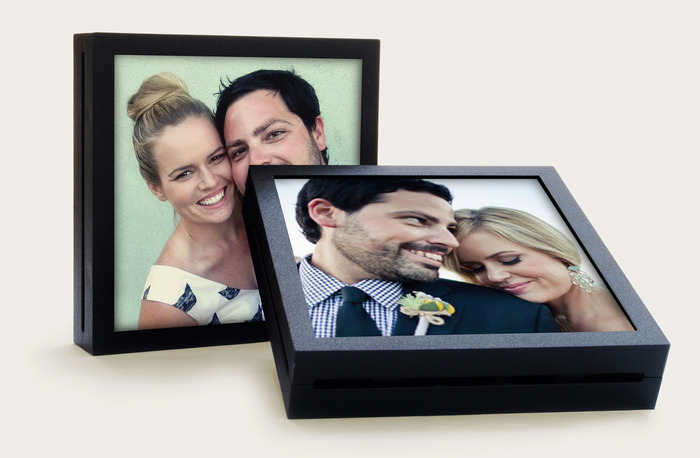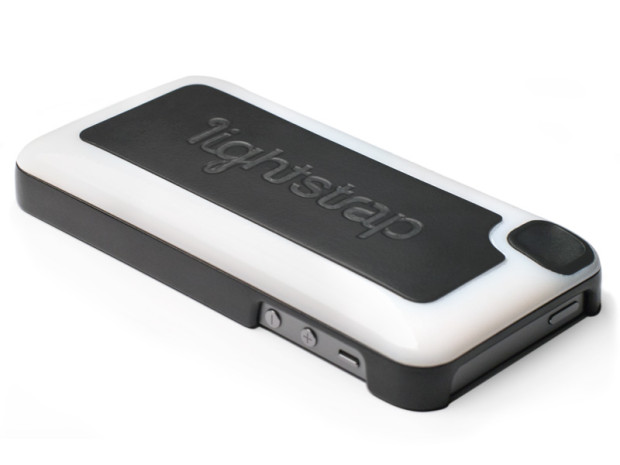The closure of IdeasTap, a valuable resource for young creative people, is a sorry loss, but also representative of a far deeper problem within society.
Eight ideas for your 2015 photography project
Click, snap, hang: showing off your prints with Fotobit
You've created a stream of several hundred, maybe even thousand, Instagram images that you love. There are landscapes and portraits and birthday cakes and bumble bees and holiday photos and you're really rather proud of a few. Now what do you do with them? Fotobit thinks that you should print them and display them in its nifty interlocking, extendable frame system that its launching on Kickstarter right now. You start with one 4×4" frame to which you can attach more frames—left or right, up or down—creating a block of images on a wall, a line of them around a room, or a zig-zag pattern of pictures. As you take more photos you can extend your display or re-arrange it to accommodate the new images.

Fotobit has already achieved its Kickstarter funding goal, but you can still pledge $30 for a three-pack of frames, $45 for a six-pack, or $65 for a nine-pack (but there aren't many of those left; when they're gone, the price goes up to $80). And there are much larger packs of frames available for even bigger pledges. The Fotobit team has signed-off on the final design and production samples; it's waiting on the Kickstarter funds to place a minimum order of frames with its manufacturers, which means that if everything goes to plan, backers should have their frames by the end of May.

'There’s nothing better than the nostalgic feeling you get when reliving a memory through a photo and I was looking for a way to share and display the countless photos I’ve taken with Instagram in a more permanent way,' says Alan Yeung, Fotobit co-founder. 'Traditional frames made the task too daunting, so that’s when I came up with Fotobit, which I hope inspires people to get photos out of their phone and onto their walls.'
You've until 24 April to make a pledge via Kickstarter.
Getty Images Grants applications open today, with awards for editorial and creative photographers
Getty Images is celebrating the ten year anniversary of its grants programme by offering a range of awards to photojournalists, portrait photographers, and non-profits working in collaboration with photographers to get their projects off the ground. There are five awards of $10,000 each being made available to photojournalists looking to pursue projects of both personal and journalistic significance as part of the Editorial Photography grants.
Previous recipients have included Paolo Marchetti, for his project Fever, which explored the re-emergence of European fascism and Lynsey Addario for the 2008 Darfur project.
Furthermore, a $10,000 Lean In-inspired grant will be awarded to a photojournalist looking to bring to light a significant but under-reported story focused on girls or women who've brought positive change to their communities or personal lives.
These awards will be judged by a panel including David Furst, International Picture Editor, The New York Times; Teru Kuwayama, Photo Community Manager, Facebook; Sarah Leen, Director of Photography, National Geographic Magazine; Jean-Francois Leroy, Director General, Visa pour l’Image; and Amy Yenkin, Director, Documentary Photography Project, Open Society Foundations.
Applications close on 15 May 2014, with more details available here.
Two grants worth $20,000 each will be awarded under the Creative Grants programme, allowing non-profits who do not currently have the resources to work with photographers or videographers to further their causes, but recognise their value, to do so. There's also a Lean-In inspired grant for this programme, which will be shared by a photographer and creative agency whose joint proposal is to develop imagery for a nonprofit they choose to support which focuses on issues related to empowering women, girls, their families, and communities.
Finally, the Contour award will offer $10,000 to support an up-and-coming portrait photographer. She or he must have fewer than five years' experience in the field, and the award will be based on their existing portraiture work. The judging panel for this will be chaired by Terry O'Neill and include Cheryl Newman, Director of Photography, Telegraph Magazine; Stuart Smith, Designer; and Michael Hirschl, Director of Creative Delivery, BergHind Joseph Agency.
More information, including terms and conditions and entry details, are available on the Getty Images InFocus blog.
What happened to the Lightstrap Kickstarter project?
Just over a week ago we featured a Kickstarter project called Lightstrap: a temperature- and brightness-adjustable ringlight set into an iPhone case, which aimed to bring better lit iPhone photos to everyone and rid us of the curse of evil red-eye. The project needed to raise a fairly sizeable $245,000, but only six days into its campaign it appeared to be well on course to achieve that with $67,197 pledged to the cause by 540 people and quite a lot of press coverage to boot. So why did Brick and Pixel, Lightstrap's developers, pull the plug on the Kickstarter campaign? In a message to its Kickstarter backers, Brick and Pixel stated that while the project appeared to be on course to hit its goal, it wasn't a slam-dunk. When it was offered the opportunity to put the Lightstrap into production through traditional channels, Brick and Pixel didn't feel that it could refuse. The campaign has been cancelled and anyone who pledged money to it won't have it debited from their accounts. Instead, they're going to have to wait for the Lightstrap to go on sale in stores and online.

As you might expect, there are quite a few disgruntled punters out there. Several of them are deeming the Kickstarter campaign a disingenuous attempt to raise the Lightstrap's profile and prove its viability as a product, lure in an external investor, and then dump the backers when a better offer came along. Quite a few would like to have been acknowledged for their support and perhaps offered a discount on the Lightstrap if and when it does make into full production. Even with those backers who remain hopeful for a positive outcome for the Lightstrap, there remains a sense of unease and there's certainly been an erosion of goodwill towards Brick and Pixel.
When I contacted Cassidy Crawson, one of Lightstrap's developers, he told me that he feels the backers' frustrations, but that it's a complicated business and they're doing their best to bring Lightstrap to fruition: 'We are deeply invested in this product (personally and financially) and we are making hard decisions with the goal of bringing Lightstrap to market successfully.' Brick and Pixel really do want the Lightstrap to make its way onto people's phones, but in one way or another they've managed to make a mistake.
Reading between the lines, it would seem that Brick and Pixel somehow underestimated what it takes to bring a product to reality, and how hard it can be to accomplish that through Kickstarter. Even when you have backers on your side, there are a great many other factors that need to be considered and you really do have to be prepared for anything. Furthermore, they also seem to have misjudged the depth of feeling that backers have for campaigns that they support. When we pledge money to projects, we're putting faith in the people behind them to deliver what they say they will. If a project doesn't reach its funding goal, that's all well and good and thems the breaks of Kickstarter. But if the project lead hasn't got it right, it's more than a sense of disappointment, there is, perhaps, an erosion of trust, too. For Lightstrap, I hope the it doesn't have a negative impact on its potential availability. For prospective Kickstarter project leads: check, check, and check again. And be prepared for anything.
In whichever way that the Lightstrap makers didn't get it right, it's a shame. I hope that they can somehow redeem themselves and finish what they've started.









